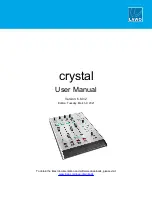
48
|
Chapter 3: Getting Started
Recommendations for Optimum Performance
•
Microplates should be perfectly clean and free from dust or bottom scratches. Use
new microplates from sealed packages. Do not allow dust to settle on the surface of
the solution; use microplate covers or seals when not reading the plate. Filter
solutions to remove particulates that could cause erroneous readings.
•
Before preparing your microplates, make sure the instrument is on and
successfully communicating with the controlling software. You may want to run a
System Test if the instrument has not been turned off/on in a few days. Design
your Gen5 protocol in advance as well, to ensure that the intended reading
parameters are used and to avoid any last-minute corrections.
•
Although the Synergy HTX supports standard flat, U-bottom, and V-bottom
microplates, the reader achieves optimum performance with optically clear, flat-
bottomed wells. See
Appendix A, Specifications
for more information on the
supported plates.
•
Non-uniformity in the optical density of the well bottoms can cause loss of
accuracy, especially with U- and V-bottom polyvinyl microplates. Check for this by
reading an empty microplate. Dual wavelength readings can eliminate this
problem, or bring the variation in density readings to within acceptable limits for
most measurements.
•
Inaccuracy in pipetting has a large effect on measurements, especially if smaller
volumes of liquid are used. For best results, use at least 100
µ
L per well in a 96-well
plate and 25 µL in a 384-well plate.
•
Dispensing solution into 384-well plates often traps air bubbles in the wells, which
may result in inaccurate readings. A dual-wavelength reading method usually
eliminates these inaccuracies; however, for best results, remove the air bubbles by
degassing the plate in a vacuum chamber before reading.
•
The inclination of the meniscus can cause loss of accuracy in some solutions,
especially with small volumes. Agitate the microplate before reading to help bring
this problem within acceptable limits. Use Tween 20, if possible (or some other
wetting agent) to normalize the meniscus for absorbance measurements. Some
solutions develop menisci over a period of several minutes. This effect varies with
the brand of microplate and the solution composition. As the center of the
meniscus drops and shortens the light path, the density readings change. The
meniscus shape will stabilize over time.
BioTek Instruments, Inc.
Summary of Contents for Synergy HTX
Page 1: ...Operator s Manual Multi Mode Microplate Reader Synergy HTX ...
Page 2: ......
Page 22: ...xviii Preface BioTek Instruments Inc ...
Page 28: ...6 Chapter 1 Introduction BioTek Instruments Inc ...
Page 52: ...30 Chapter 2 Installation BioTek Instruments Inc ...
Page 72: ...50 Chapter 3 Getting Started BioTek Instruments Inc ...
Page 102: ...80 Chapter 4 Preventive Maintenance BioTek Instruments Inc ...
Page 166: ......
Page 174: ...150 Appendix A Specifications BioTek Instruments Inc ...
















































